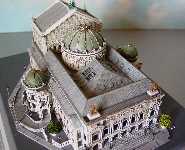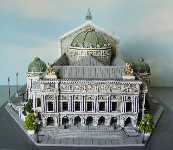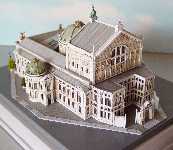


PARIS OPERA (Garnier) . Paris, France . 6.5" x 8.5" x 4" tall



PARIS OPERA (Garnier) . Paris, France . 6.5" x 8.5" x 4" tall
|
In 1858, as Emperor Napoleon III and his wife were arriving at the old opera house in Paris, three bombs were thrown at the royal entourage. 150 people were either killed or injured. Shortly thereafter, the Emperor directed that a new opera house be built. It would not only be the envy of the world, but it would have an Imperial side entrance that could be adequately guarded. An architectural competition was held to design the new opera house and 171 entries were received. The winner was a relatively unknown architect, Charles Garnier who said his style was "The Napoleon III style". Construction began in 1862, but was quickly suspended after the discovery of an underground lake. Although this problem was overcome, the lake still exists and lies beneath the cellars of the building. Thus, "The Phantom of the Opera" legend by Gaston Leroux, was born. The opera is a large building with a total of 118,404 square feet and a vast stage with room for up to 450 artists. It is still the largest opera house in the world in terms of size. However, it only seats 2156 people while La Scale in Milan, seats 3500. But the Paris Opera was designed as a setting for grand state occasions, for galas and balls, festivals and feasts. The foyers and lounges, the Grand staircase and other public parts of the building take up more space than the auditorium. There are 80 separate dressing rooms for principal performers and 8 large dressing rooms for extras. The exterior is also richly ornate, decorated with friezes, columns, winged figures and other embellishments. Construction of the opera would be the most costly expenditure of the Second Empire. Recently renovated, The Opera Garnier (or Palais Garnier, as it is sometimes called) is truly one of the most spectacular buildings in Paris. Today it is often the site of ballets. Operas are generally performed at the new Opera Bastille - a building that is not very popular. |
| CLOSE THIS PAGE |